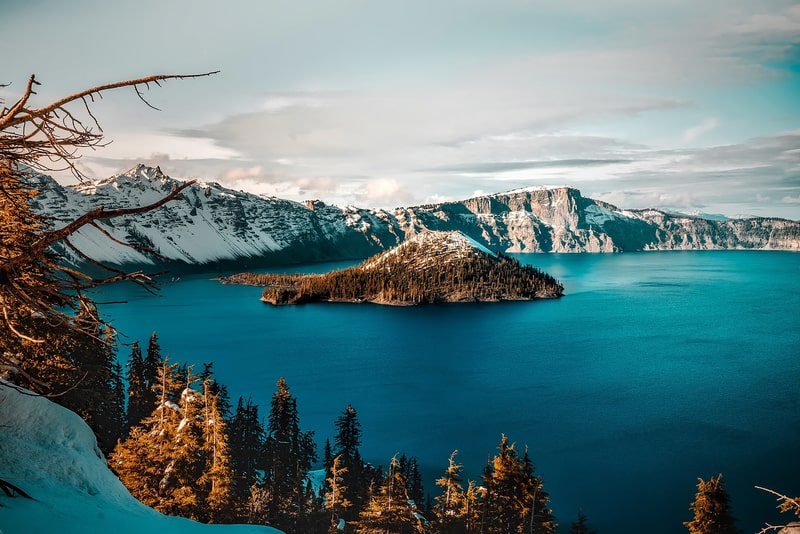
Crater Lake Facts
- Perhaps most notably, the mind-blowing site known as Crater Lake remains best known, and in fact quite famous, for two distinctive things. These aspects, quite understandably, consist of the gorgeous color and incredible clarity of the water contained within its boundaries.
- In fact, the magnificent lake routinely ranks in the top five in the world among bodies of fresh water with the greatest clarity. The famous distinctive bluish hue of the waters for which its world renowned occurs due to the combination of its great clarity and extreme depth.
- But, the remarkable uniqueness of this marvel of Nature does not end there. This wonder of geology also has two small islands situated within its beautiful confines. These two remarkable natural wonders bear the highly intriguing names of Wizard Island and Phantom Ship.
- Archaeological evidence clearly indicates that Native Americans knew of the gorgeous site now called Crater Lake for millenia prior to its discovery by non-native explorers. The local tribe, the Klamath people, in fact, knew the site by the name of giiwas in their language.
- The first recorded sighting of this tunning formation by an outsider, though, took place at the hands of a small group led by John Wesley Hillman. Gold prospectors at the time, the three men stumbled upon the natural marvel accidentally, in the year 1853, during their search.
- Due to its incredible beauty, this breathtaking location now represents the central piece of Crater Lake National Park. It understandably serves as one of the most popular tourist destinations in the region. Authorities nevertheless take pains to maintain its pristine state.
Related Articles
Crater Lake Physical Description
The astonishing Crater Lake almost instantly captivates those individuals fortunate enough to visit the mesmerizing site. The marvel does so at first glance, of course, simply due to its sheer beauty. Yet, this lake additionally does so when they learn more of its physical attributes and statistics.
Perhaps chief among these stands the fact that, along with its magnificent visual splendor, comes the discovery that it’s also the deepest lake in the country it formed in. In the deepest recesses of its clear waters, the bottom lies an astounding 1,949 ft (594 m) below the water’s surface!
This ranks the amazing formation as the ninth in the entire world in terms of its depth. But, that isn’t its only distinctiveness, to be certain. The wonder also has a relatively large overall area. The lake additionally has a slightly rectangular shape, measuring roughly 5 mi by 6 mi (8 by 9.6 km).
One of the most striking features of this stunning body of water continues to be the intense blue color of that liquid. The lake’s clarity and deep blue hue form due to its purity and depth. This specific combination allows sunlight to penetrate deeply and scatter blue wavelengths.
Fantastic Crater Lake also qualifies as unusual for yet another intriguing reason. It actually has no bodies of water flowing into it. In a remarkable natural balance, evaporation’s roughly compensated for by regular rainfall and melting snow. This makes it one of the few such lakes on earth.
Within the lake itself lie the two notable islands mentioned, Wizard Island and Phantom Ship. Wizard Island’s a cinder cone that rises about 764 ft (233 m) above the water’s surface. But, Phantom Ship, is a small rocky island resembling a ghost ship, with spires rising from the water.
Crater Lake Location, Formation, and Ecology
The breathtaking Crater Lake formed in a region of the globe already well known for its great abundance of marvelous geological wonders. That area therefore won’t surprise too many of our readers. That’s because it sits within an area of what’s now the continent of North America.
More precisely, Nature created the magnificent pristine lake in what now constitutes the state of Oregon, located in the United States. That particular state sits in the far northeast portion of the country. The body of water itself, furthermore, lies roughly in the south-central region of that state.
Amazingly, this lake sits inside the caldera of an extinct volcano, named Mount Mazama. This volcano apparently erupted quite violently approximately 7,700 years ago, leaving the namesake crater. Part of the Cascade Range, this volcano has now been completely quiet for about 6,000 years.
Nevertheless, Nature constantly keeps us on our toes. Minimal amounts of geothermal activity still routinely appear along the floor of the breathtaking mountain lake. This further indicates that, although considered unlikely, the volcano holds the potential to perhaps one day erupt again.
The waters of Crater Lake also nourish and support a fully thriving ecosystem. Due to the nature of its origins, of course, no native fish species exist within its confines. Several were introduced, however, with two species still surviving. The endemic Mazama newt does live there, though.
Obviously, however, since its formation, numerous types of phytoplankton and microscopic algae have slowly developed in the lakes waters. With their persistent presence, the lake also now directly supports sizeable populations of various zooplankton, small crustaceans, and insect larvae.
The dense forests surrounding and nourished by it are largely dominated by various coniferous trees such as Douglas fir, white fir, and ponderosa pine. These forests, in turn, provide a safe habitat for a variety of wildlife species. Those fauna include black bears, deer, and numerous bird species.
Features Sharing Its Region
Check out our other articles on 9 of the Weirdest Animals on Earth, Caracal, Cango Caves, Reticulated Python, Wolffia angusta,Vampire Moth, Banded Piglet Squid, Golden Pheasant
